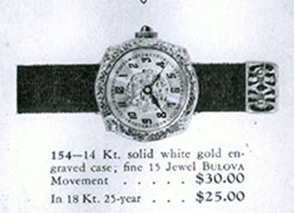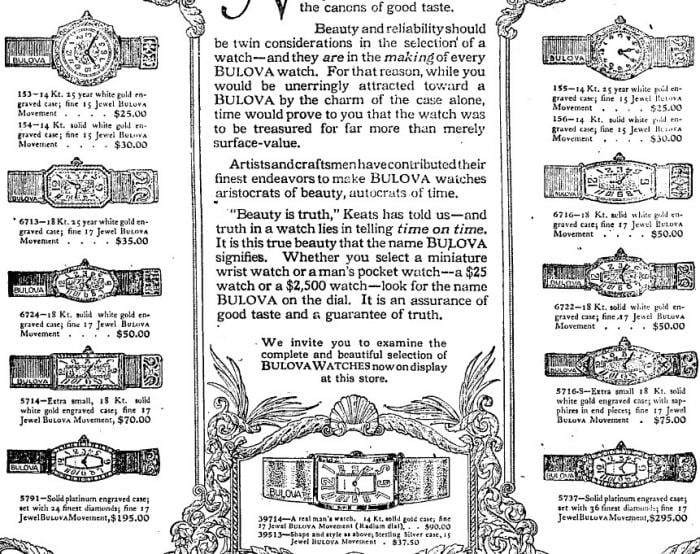The hands are of a blued type of metal. Lapis or sapphire in the winding stem. Engraved on the front and back. The face where the hands sit has stripes. It has the original band. It looks like the 1922 158 however that watch does not advertise with a metal/gold band.Rumor has it that this watch was a wedding gift to my great grandmother. Their first child was born in 1902. That would place this watch at 1902 or prior if the story holds true.
Nice family heriloom. The movement signature of Bulova Watch Co. dates the movement to 1924 or later. We have examples of the 10A in the movement database from 1923-1926. The first digit of the inside case serial number is used to date the case by decade, so this number beginning w/ a 6, dating the case to 1926. Hope this helps.
I agree w/ the 1926 model 153 ID.
EDIT: I did'nt read closly. I'm thinking we all mean 154, not 153?? Here's on 1923 ad snippet- click for full ad in database:

I cannot find the symbol on this can someone point me to it? If after 1924 it should have the symbol correct? Also, the watches you have identified do not have stripes where the hands attach in the middle, they have flowers. This one has stripes. Also the models you identify don't look as if they were sold with a metal band. The band on this watch is the original. Thanks for all your input everyone!
In reply to I cannot find the symbol on by cmartin
Not all early movements have a date code symbol on them. The period where this is common is around 1924-26ish. The "Bulova Watch Co" movement signature was used from 1924 on. There may have been some early 1924 movements made with the "Bulova W Co" signatures, but I don't think so. So the movement dates 1924 at earliest (and lacking a date symbol). The "Bulova Quality" inside the American Standard case suggests 1924 or later also. The earlier American Standard cases made for (and probably by) Bulova lacked the Bulova wording. As best as we can determine, American Standard may have been a partially owned subsidiary of Bulova in the late teens early 1920's, and became a wholly owned subsidiary of Bulova sometime in the 1920's...The transition from no Bulova on these cases to including Bulova w/ Am Std markings makes sense as a possible transition date to the wholly owned subsidiary.
The dials had variation which may or may not have resulted in a different model name. ...and it's very difficult to determine if the band is original, as the bands are the first think to go. It could have been replaces with a period-correct band, so unless we have an ad showing that band on a (very similar) watch, it's a safe assumption not to count it in the ID'ing process.


